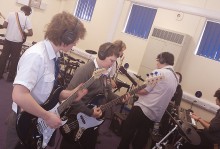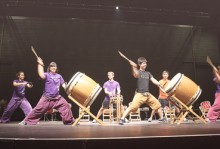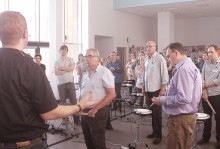As we get ready for the Brazil Olympics in three years time, we need to get ready for a drumming artform the inspires many but scares an equal amount! Say the name Samba in the majority of schools across the UK and the response you will get is likely to be pained…..performed poorly, which it so often seems to be; Samba can be perceived as just a lot of noise. Performed well it is a different story. When Wider Opportunities was launched the default position for many was Samba. Drums have always been treated with distain by many; they perceive it as easy and so in those early Wider Opportunities days you had non percussionists doing their best but teaching something they had little or no knowledge about.
- Performed well, Samba is a vibrant, energetic slice of Brazil. It enables you to use all the drums lying around school, to learn how to truly feel music and teaches that all elusive skill, how to make a piece of music really feel good. If you can make a piece feel good, you can make it groove. Let’s learn how we do it….
- Many approaches work, but I have found the one I will show you to be the easiest for students and for tutors. I developed this approach in primaries, secondary’s and community Samba projects across the UK. I was lucky enough to be involved with Wider Opportunities from the start, I learnt a lot of the do’s and do not’s along the way. The following is a condensation of that work.
Session 1
- Get your group into a circle facing inwards
- Make sure everyone knows their left from their right
- Ask all to put their left foot in, just like the song. But get them to keep it there
- Anyone who has got it wrong will rectify quick, trust me. You won’t need to say a word
- Now count 1,2,3,4 steadily and repetitively, this is the pulse of your samba
- Get everyone to join in
Now march on the spot, left on 1, right on 2, left on 3, right on
- Make sure everyone continues to count, no shouting just clear speaking voices
Challenge: The Samba Groove
- For me this is the key to it all. Getting your students to move to the pulse you have created. This challenge will need regular practice so don’t give up!
- Instead of marching as above, this time we need to move side to side
- Step to your left on 1 and left with your right foot on 2. Continue the move right on 3 and right with your left on 4
- Demonstrate this slowly first for the group, then stop
- Now everyone needs to stop counting aloud, instead using their head voices
- Count in as you normally would, but this time move without speaking
Succeeding in this challenge will create a moving circle that helps students and teachers learn to feel the music you will create. It’s a great thing to be part of, students of every age will enjoy getting this right so don’t be afraid to give it go.
Session 1 Surdo Pattern
The Surdo is the power behind your Samba. When played well the tones are so low you feel this rather than hear it. It is a wonderful instrument with a basic pattern, but it is the most important of all, so take time to get it right.
- Continue in your circle
- Introduce crotchets and quavers to the group
- As the group steps left on beat one everyone should say ‘Tea’
- As the group brings their right foot left on beat two everyone should say ‘Coffee’
- As you step right for the first time on beat 3 say ‘Tea’, as you bring your left foot right on beat four say ‘Coffee’
- Practice this as a group until everyone feels comfortable
Session 2
- Get your group back in a circle and get your Samba Groove going
- Remember to count yourselves in and if you need to, initially keep counting so everyone gets used to the pulse
- Turn off your voices…..keep moving. If anyone gets out of step the chances are they are not using their head voice. Remind everyone to keep saying 1,2,3,4 in their heads
- Revisit the Surdo Pattern from Session 1
Challenge: Splitting your Surdo Pattern
- Once you feel the pattern from Session 1 is feeling good, split the group in twoGroup 1 will now play the ‘Tea’ pattern on beats 1 & 3
- The best way to do this is straight down the middle eg one side of the circle is group 1, the opposite side of the circle is group 2
- Group 2 will play the ‘Coffee’ pattern on beats 2 & 4
Once the above feels comfortable, swap the groups around eg Group 1 play ‘Coffee’, Group 2 play ‘Tea’
Session 3
- Get back into your circle and get your Samba Groove moving
- Once everyone is warmed up and engaged, stop the group
- Everyone playing ‘Tea’ should pat their legs instead of clapping their hands
- Everyone playing ‘Coffee’ should pat their chests instead of clapping their hands
Challenge: Adding the Ganzar Pattern
A Ganzar is effectively a tin with dried peas in it; you may have something like this in school. If not, anything that is light and makes a noise when you shake it will do.
- Add a third group to your circle
- Group 1 and 2 should continue with their Surdo pattern
- Group 3 will play their shakers (Introduce instruments to the shaker group immediately)Try it initially with group 3 then stop and bring groups 1 & 2 back in
- The Ganzar pattern is as follows coffee, cocacola, coffee, cocacola
- Try saying it all together first, make sure everyone is listening to each other so they say it at the same time
- To add the pulse, get your Samba Groove going again
- Remember how we played ‘Tea’ on one and ‘Coffee’ on two etc.?
- Group 3 plays coffee on one, cocacola on two, coffee on three and cocacola on four
Once the above feels comfortable, swap the groups around so everyone gets a chance to try the new rhythm.
Session 4 – Introducing Surdo’s
Surdo’s are large aluminium drums that are usually carried with straps. If you don’t have Surdo’s ideally tom tom style drums will do, but I have even used tambour’s before (tambourines without the bells). If you only have a few drums, everyone else can keep doing the body percussion
- Get back into your circle and get your Samba Groove moving
- Once everyone is warmed up and engaged, stop the group
Introduce the Surdo drums
- If you have a mix of sounding drums, give all the higher pitched instruments to the tea group and all the lower pitched instruments to the coffee group
Challenge: Learning how to stop!
You have already learnt how to get started as a group by counting yourself in. This is how we stop:
- Once the Surdo players have all had a go with a drum, stop the group
- The best way to stop a Samba is with a football whistle although any loud whistle will do
- To stop the group you will blow on your whistle 5 times. You must do this in time with your Samba Groove eg each blow will be at the same time as you move your feet
- If you don’t have a whistle you could use a hand signal
- Raise your fist in the air to attract the groups attention
- Raise each finger in turn, with the group stopping when your hand is held open
Session 5
Revisit all the work we have done so far.
- Get your group in a circle and practice the Samba Groove
- Split the group in two and add the Surdo Pattern
- Split the group in three and add the Ganzar Pattern
- Practice starting and stopping
Challenge: Adding the Caixa Pattern
The Caixa is the Brazilian version of a snare drum. Any small high pitched drum you can get hold of will work great.
- Add a fourth group to your circle
- Practice the Caixa Pattern with group 4Say it as a group first before you try playing it
- Caixa pattern : Mexico Cuba Mexico Cuba (Mexico on 1, Cuba on 2, Mexico on 3, Cuba on 4)
- Once it feels settled introduce the Surdo pattern
- Then finally introduce the Ganzar Pattern
- Now practice starting and stopping
Practice the above as much as you need to until it feels comfortable eg not too many things are going wrong. If something does go wrong try not to stop. Try introducing some quieter parts by using your hands. Tell the group when your hands are close together they must play softer, as you move your hands further apart they must gradually get louder.
Performing your Samba
You may not believe it but you are now ready to perform! You will learn more from performance than you did in your lessons so make the leap of faith and get out there. From here you have the basics to take Samba further if you wish to. There are a huge amount of superb resources out there which will help you on your way; the internet is a great place to start.
The most important thing is keep it fun. Encourage your students to smile as they play and really enjoy the experience. Keep a hold of the volume; if it feels too loud to you, it is, so do something about it. Also, if you can introduce some quieter sections, that will add a lot to your performance. Good luck!
For more help or advice with lesson plans, training or sourcing drums contact me at dan@mixmusiceducation.co.uk








